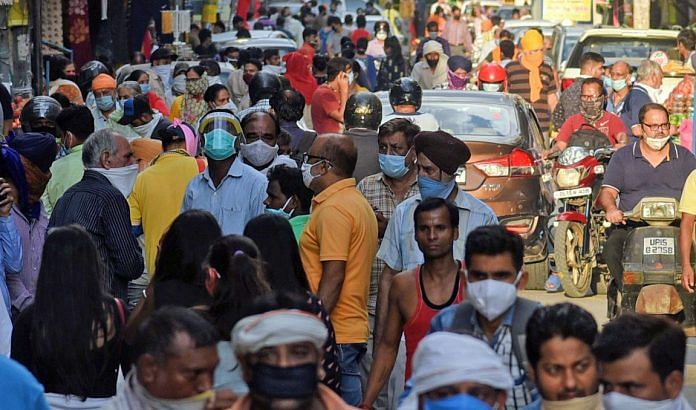New Delhi: The Covid-19 daily case count in Delhi crossed the 4,000-mark for the fifth consecutive day Monday, and a major cause for concern is that the Rt value has also been on the rise.
While the Aam Aadmi Party (AAP) government insists that cases are rising due to increased testing, data analysed by ThePrint reveals that Delhi’s Rt value has seen a substantial increase since June when the capital recorded a high in the infection rate.
In comparison to the Rt value of 0.81 on 26 June, the Rt value in the capital as of 13 September is 1.28.
Rt value, known as reproduction number, is indicative of the number of new cases expected to emerge from a single case. The World Health Organization (WHO) recommends the Rt value as the key measure to know the rate of infection in a country. It reflects how many people a single infected person is likely to spread the disease to. The Rt value then indicates the severity of the outbreak of the disease — a Rt value below 1 indicates that the disease is under control.
As of 13 September, Delhi recorded a total of 2,18,304 cases with 4,744 deaths and 1,84,748 recoveries.
Rise in Rt value despite ramped up testing
According to covidtoday.in, a volunteer research group that has been compiling Covid data across the country, Delhi’s Rt value on 26 June was 0.81. As of 13 September, the Rt value almost doubled to 1.28.
This despite the fact that Delhi has almost tripled daily testing in comparison to June. While Delhi was conducting only 17,533 daily tests on 26 June, it conducted 56,656 tests on 13 September. On 26 June, Delhi recorded 3,460 cases, while the daily count on 13 September was 4,235.
The Delhi government has claimed that the surge in cases is only due to ramped-up testing in the capital. On 5 September, Delhi Chief Minister Arvind Kejriwal said, “The numbers of Covid cases are rising because more and more tests are being done every day. The more we test, the more we find out about cases. In a way, we have launched a counter-attack on coronavirus.”
However, despite increasing testing capacity, the Rt value has not gone down in the capital. ThePrint tried to contact Delhi government’s Director General of Health Services Nutan Mundeja and Health Secretary Padmini Singhla through phone calls as well as text messages but received no response till the time of publishing this report.
‘Rt rise due to unlock measures, people’s complacency’
Experts that ThePrint spoke to said the rising Rt value is consistent with the rising infections in the capital. “As cases increase, Rt value will also increase. It simply shows the speed of spread of the epidemic,” said Dr T. Jacob John, a virologist and former professor at the Christian Medical College (CMC) in Vellore.
They also said the rise in the Rt value has been recorded due to ‘Unlock’ activities and people’s failure to comply with social distancing measures.
“Due to unlock measures, all normal activities are back on track, which explains the increase in Rt value. In addition, people who had left Delhi for their hometowns are also returning (and) that has contributed to the increase,” said Dr D. Prabhakaran of the Public Health Foundation of India. “Most importantly, people have become lax and not complying with social distancing measures or wearing masks.”
Experts said infections are increasing also because many of those who are getting infected are asymptomatic. “Many of the people venturing out now are not taking adequate precautions and with many infected remaining asymptomatic or mildly symptomatic, the number of people to whom the infection is being transmitted from an infected person at a particular time is increasing,” said Dr Ananth Bhan, a researcher in global health and bioethics.
Experts also said this implies the need for reinforcement of public engagement around continuing risks, and the need for caution. “If people start observing appropriate Covid behaviour and wear masks and practise social distancing, the Rt value will come down,” said Dr Prabhakaran.
Also read: Yellow, Blue, Magenta, Red — Delhi’s metro lines are now running like it’s business as usual






